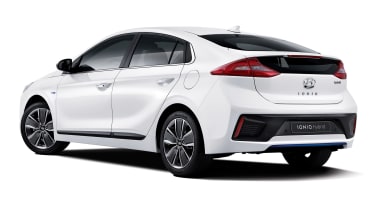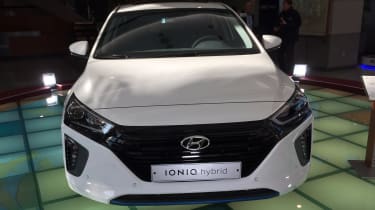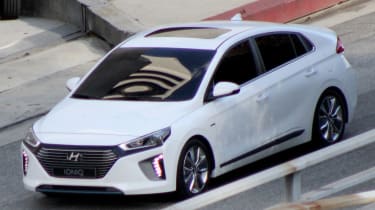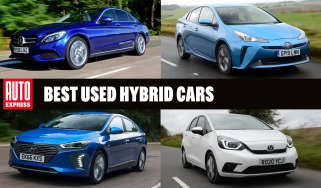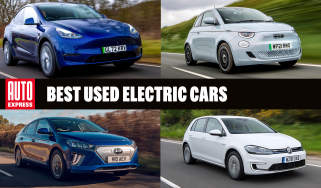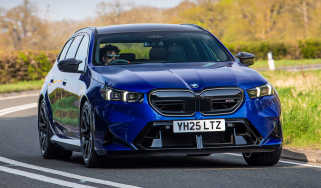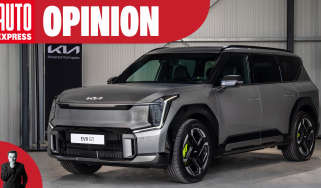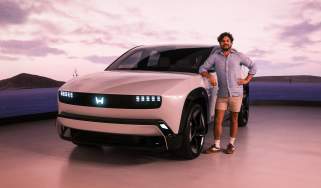New Hyundai Ioniq 2016: full UK pricing and specs announced
Hyundai reveals its Toyota Prius rival will start from £19,995, and go on sale in October
After its Geneva Motor Show debut, Hyundai has announced full UK pricing of its all-new Ioniq eco hatch. The Toyota Prius rival starts from £19,995 in hybrid form and is available to order from October, with full EV and plug-in models ready later.
The base Ioniq Hybrid SE comes with 15-inch alloy wheels, DAB with Bluetooth, cruise control, rear parking sensors, a rear-view camera, autonomous emergency braking and lane-keep assist. At just under £20k it undercuts the entry-level Prius by over £3,000.
Jump up to Premium spec, from £21,795, and you'll also get keyless start, heated front seats, a heated steering wheel, xenon headlamps and sat-nav with Apple CarPlay and wireless charging, plus a 7-inch display in the instrument cluster showing powertrain and driving info.
Flagship Premium SE models get luxuries such as ventilated electric leather seats, heated rear seats, blind-spot detection, parking assist and 17-inch alloy wheels. All models get the same 1.6-litre petrol engine with electric motor and six-speed dual clutch autobox, providing 139bhp and powering the Ioniq from 0-62mph in 10.8 seconds.
Hyundai isn't yet quoting MPG figures for the Ioniq, but it does reveal a CO2 figure of 79g/km: That's 9g/km more than the entry-level Prius. But those looking for the most eco-friendly model should look at the pure-EV.
The Ioniq Electric starts from £28,995, based on Premium spec but also adding auto wipers, 16-inch alloys, LED headlamps and adaptive cruise control. Instead of the petrol engine, it uses a 119bhp electric motor offering up to 174 miles on a charge, with an 80 per cent recharge function in 33 mins.
Hyundai Ioniq styling
The Ioniq is a much more conventionally designed car than the extrovert Prius, with a five-door bodystyle but a low, almost coupe-like roofline. At the front, the grille has a similar hexagonal shape to that of the new Genesis G90 seen at this year's Detroit Motor Show and a rear spoiler built in to the boot hatch like the latest Prius and the current-generation Honda Civic. Blue accents at the bottom of the bumper mark the Ioniq out as an eco model.
• Hyundai and Kia plan eco-explosion with major hybrid tech roll out
Focus on aerodynamics
The Korean firm claims the outside of the Ioniq has been primarily designed to offer "class-leading aerodynamic performance", thanks to the slippery shape and details such as moving flaps in the front grille that direct airflow around the car.
And the figures seem to back that up, with a drag coefficient of 0.24Cd, which is on a par with the new Toyota Prius and significantly better than the likes of the Volkswagen Golf (0.31Cd).
The real innovation is under-the-skin, however. The Ioniq is set to be the world's first production car with fully electric, hybrid and plug-in hybrid powertrain options in the range.
• Genesis G90 heads up Hyundai's premium sub-brand
The first of the Ioniq models to be revealed is the Hybrid, or HEV. It uses a 104bhp 1.6-litre naturally-aspirated 'Kappa' petrol engine, which Hyundai claims has "the world's highest thermal efficiency" at 40 per cent. It is paired with a magnetic electric motor providing another 43bhp.
The lithium-ion battery that 'fuels' the electric motor is said to offer "outstanding charge and discharge performance” compared to a nickel-metal hybride pack, such as that found on the Prius.
Another key difference with the Prius is the use of a six-speed dual clutch transmission, rather than the Japanese model’s CVT. Hyundai is bullish with regard to the benefits the DCT has for the car’s performance on the road.
“An advantage we have is the dual-clutch transmission,” explained Woong-Chul Yang, vice chairman, Namyang Research and Development Centre. “It is very well fitted to our hybrid systems. It gives dynamic driving ability. Electric CVT doesn’t have any dynamics.”
• Hot Hyundais on the way as Hyundai N performance division confirmed
The focus on driving fun is paramount for the Ioniq, with Yang adding: “It is a hybrid with no compromises in performance at all.”
All-new platform for Hyundai Ioniq
The Ioniq is based on a new platform, specially developed to house the lithium-ion batteries on board. The batteries will be used to save fuel in the hybrid models, and of course, provide the power to the electric motors that drive the wheels in the fully-electric version.
Hyundai executives did drop some big clues at the car’s launch event. “For range, Ioniq is also well beyond [the Kia] Soul,” continued Yang. And Ki-Sang Lee, Hyundai’s senior vice president, head of eco-friendly tech centre, added: “Our driving range on our EV is bigger than our competitor that starts with an N,” [clearly referring to the Nissan Leaf].
Hyundai Ioniq interior design
Inside, there’s an uncluttered dash layout, with a blend of soft-touch plastics, and some harder ones in less obvious areas. The eco-credentials are bolstered again by the use of eco-friendly materials – the interior door covers, for example, are made from recycled plastic, powdered wood and volcanic stone to reduce weight.
As per the outside, there’s more blue detailing, notably round the air vents, which provides a welcome contrast to the dark colours in the model we sat in. A seven-inch TFT information cluster infuses the Ioniq with a dose of hi-tech appeal, while an eight-inch colour touchscreen is available with Apple CarPlay and Android Auto compatibility.
• "Hyundai has been transforming how people buy cars"
The Ioniq is practical, too, with adequate space for six-footers in the rear and a boot capacity of a generous 750 litres. The Hybrid is likely to go on sale in the UK in October 2016 alongside the pure EV, with the plug-in hybrid following on at a later date. Prices have yet to be confirmed, but bosses are claiming that the model will be competitive with the Prius, meaning it is likely to undercut it.
Why is it called Ioniq?
And the name? The Ioniq name is a combination of the word ion, an electrically-charged atom, and the word' unique'. Woong-Chul Yang said: “Our vision for future mobility focuses on choice, with a variety of powertrain options to suit customers’ varied lifestyles, without compromising on design or driving enjoyment. Ioniq is the fruit of our efforts to become the leader in the global green car market.”
All-electric Hyundai Ioniq: driving impressions
The Ioniq EV is one of 22 eco-friendly models to be launched by Hyundai and sister firm Kia before 2020. Among the obvious visual differences from the Ioniq Hybrid are the blanked-off grille, bronze-coloured detailing and, of course, the lack of exhaust pipes. Boot capacity is also slightly smaller than on the Hybrid due to the larger battery pack..
From behind the wheel, instant torque delivers excellent immediate acceleration, although it doesn’t feel quite as brisk as BMW’s electric i3 supermini. The car we drove was a protoype that was tuned for the Korean market and felt quite soft – although we are assured the EV will be set up to suit European buyers’ tastes when it goes on sale in the UK alongside the Ioniq Hybrid in October. Cabin refinement could be improved too – there was a lot of intrusive wind noise on a blustery day at Hyundai’s Namyang facility.
One interesting feature are steering-wheel mounted paddles that allow the driver to regulate the regenerative braking when their foot is off the pedal. Using these sensibly will help to increase the range.
Meanwhile, Hyundai has also said it is targeting a 32-mile electric range and CO2 emissions of just 34g/km from the third and final Ioniq model – the plug-in version.
What do you think of the Hyundai Ioniq? Let us know below...
Find a car with the experts

